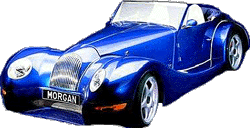


BY DESIGN
By
Robert Cumberford
Getting it all wrong
Forty
years ago, driving from New York to Mexico City, I stopped in a little
town south of Monterey known for basket weaving. A really beautiful woven-reed
picnic basket tempted me, but I decided to pick one up on the way back
to the States. The one I bought six months later—and still use—looked just
as nice, but its bottom panel is a piece of particle board. obviously,
it was easier and cheaper to make, but looked much the same. I didn't mind
that incorporated modern materials in a traditional design, since it didn't
show.
A year
later, I visited the same town and discovered an aesthetic disaster. Someone
had sold the towns people endless rolls of extruded plastic band with four
half-round shapes incorporated in it. The weavers were making baskets with
this nasty stuff. Giving them a coarser surface and an unpleasant,
shiny look. The towns products had changed from beautiful traditional objects,
refined over hundred of years. to cheap and nasty tourist crap. The basic
function, of the picnic baskets—being containers—still existed, but they
looked awful. Some change is all right. Too much change is, well, too much.
I thought
about that as looked at the grotesque Morgan Aero 8 at the Geneva show
this spring. Third generation Morgan Motor Company proprietor Charles Morgan
has given the venerable company something it has needed and merited
for a very long time; a modern chassis with fully independent suspension
and a thoroughly modern engine. In effect, this returns to the days of
Morgan three wheelers, which suspended each wheel individually, not that
there was much flex in their springs. No question, a new chassis
was a good idea. That the one developed is expensive is unfortunate, but
the very best in technology is always extremely dear, and even mid-range
stuff, like the new Morgan's riveted and bonded aluminum chassis, is usually
more expensive than what it replaces, at least at first.
 The
problem with the new car lies in its styling, a ham-handed amateur attempt
to combine Thirties shapes with contemporary racing aerodynamics. I presume
that the new shape works very well for penetration and down force and that
it has been seriously developed, but its look, not to put too fine a point
on it, is absolutely disgusting. It's easy to understand why Morgan
has tried to keep some of its basic 1935 styling. Years ago, an ungainly
fiberglass envelope body was plopped down on the ancient Morgan chassis
by second generation proprietor Peter Morgan. The Plus Four Plus was a
complete failure in the market place, with only twenty-odd sold before
it was scuttled. Imagine a then-modern body on an antique chassis that
twisted and flexed and caused the plastic skin to crack; you obviously
had the recipe for a commercial disaster, but Peter Morgan didn' t see
it that way. He told me that the car was extremely beautiful, much better
than its contemporary, the first Lotus Elite, but that it failed because
people wanted a Morgan to be traditional. No, it failed because 1) it was
ugly and 2) it was functionally deficient viz the twisting and cracking.
The
problem with the new car lies in its styling, a ham-handed amateur attempt
to combine Thirties shapes with contemporary racing aerodynamics. I presume
that the new shape works very well for penetration and down force and that
it has been seriously developed, but its look, not to put too fine a point
on it, is absolutely disgusting. It's easy to understand why Morgan
has tried to keep some of its basic 1935 styling. Years ago, an ungainly
fiberglass envelope body was plopped down on the ancient Morgan chassis
by second generation proprietor Peter Morgan. The Plus Four Plus was a
complete failure in the market place, with only twenty-odd sold before
it was scuttled. Imagine a then-modern body on an antique chassis that
twisted and flexed and caused the plastic skin to crack; you obviously
had the recipe for a commercial disaster, but Peter Morgan didn' t see
it that way. He told me that the car was extremely beautiful, much better
than its contemporary, the first Lotus Elite, but that it failed because
people wanted a Morgan to be traditional. No, it failed because 1) it was
ugly and 2) it was functionally deficient viz the twisting and cracking.
But
the family lore about the Plus Four Plus has had its effect on Charles,
who has valiantly tried to preserve the traditional narrow cockpit,
inadequate luggage space, flat windshield and cut-down doors of 1935 in
the Aero 8. That he took from his father is admirable, but it is tragic that
he did not understand what people are buying when they order a Morgan.
Morgans are pretty awful automobiles by modern standards, but many people,
me included, love them for one good reason, they look wonderful and are
authentic period pieces. True, over the past sixty-five years, the grille
and the headlamps have changed, the proportions have been altered here
and there—doors are longer, width has increased, overall height has been
reduced—but the basic look has been constant, and the traditional shapes
haven't been compromised by attempts to "modernize" the straightforward,
honest Thirties style. The cross-section of the fenders has remained
the same radius-cornered rectangular shape, even though it has become wider
over the years to accommodate ever-wider tyres. When you see a Morgan you
know what it is, just as you always recognize a Porsche 911, even if not
a single surface is identical between the first model and the latest.
And,
like Porsche, Morgan has met every legal requirement imposed on manufacturers.
The engines have catalysts, cockpits have air bags, crash tests have been
met, and standards have been surpassed, all without destroying the ambiance.
Up to now.
Where
these two icons diverge is in the way development has been managed. Both
firms have maintained racing programs which give their products an
aura of seriousness. With the new car, Morgan is trying to put a
racing car on the road while Porsche has realized that what its customers
want is daily-use practicality. Once you accept the usual limitations
of two seaters—the lack of space and the awkward entrance conditions—there
is no better everyday sporting car than a Porsche 911. Morgan is
now trying to peddle a racer with a blobby, cross-eyed nose that ensures
aerodynamic downforce for a clientele that may enjoy a burst of speed from
time to time but appreciates more a gentle top-down trundle through
the countryside in a pretty car.
I asked
Charles Morgan if the company would be prepared to build cars
with the old bodywork on the new chassis. All that question got me
was a sharp poke in the diaphragm from the Morgan index finger, but
I suspect it will be asked by others whose orders are already in on the
years-long queue for a new Morgan. I hope their answer will be a
bit more accommodating.
I would
hate to see my favorite sports car company disappear beneath the weight
of erroneous assumptions.
BACK
 The
problem with the new car lies in its styling, a ham-handed amateur attempt
to combine Thirties shapes with contemporary racing aerodynamics. I presume
that the new shape works very well for penetration and down force and that
it has been seriously developed, but its look, not to put too fine a point
on it, is absolutely disgusting. It's easy to understand why Morgan
has tried to keep some of its basic 1935 styling. Years ago, an ungainly
fiberglass envelope body was plopped down on the ancient Morgan chassis
by second generation proprietor Peter Morgan. The Plus Four Plus was a
complete failure in the market place, with only twenty-odd sold before
it was scuttled. Imagine a then-modern body on an antique chassis that
twisted and flexed and caused the plastic skin to crack; you obviously
had the recipe for a commercial disaster, but Peter Morgan didn' t see
it that way. He told me that the car was extremely beautiful, much better
than its contemporary, the first Lotus Elite, but that it failed because
people wanted a Morgan to be traditional. No, it failed because 1) it was
ugly and 2) it was functionally deficient viz the twisting and cracking.
The
problem with the new car lies in its styling, a ham-handed amateur attempt
to combine Thirties shapes with contemporary racing aerodynamics. I presume
that the new shape works very well for penetration and down force and that
it has been seriously developed, but its look, not to put too fine a point
on it, is absolutely disgusting. It's easy to understand why Morgan
has tried to keep some of its basic 1935 styling. Years ago, an ungainly
fiberglass envelope body was plopped down on the ancient Morgan chassis
by second generation proprietor Peter Morgan. The Plus Four Plus was a
complete failure in the market place, with only twenty-odd sold before
it was scuttled. Imagine a then-modern body on an antique chassis that
twisted and flexed and caused the plastic skin to crack; you obviously
had the recipe for a commercial disaster, but Peter Morgan didn' t see
it that way. He told me that the car was extremely beautiful, much better
than its contemporary, the first Lotus Elite, but that it failed because
people wanted a Morgan to be traditional. No, it failed because 1) it was
ugly and 2) it was functionally deficient viz the twisting and cracking.

